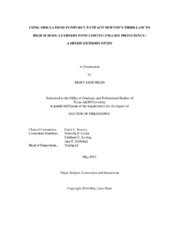| dc.contributor.advisor | Stuessy, Carol L | |
| dc.creator | Head, Mary Jane | |
| dc.date.accessioned | 2015-01-09T20:25:56Z | |
| dc.date.available | 2016-05-01T05:30:52Z | |
| dc.date.created | 2014-05 | |
| dc.date.issued | 2014-04-18 | |
| dc.date.submitted | May 2014 | |
| dc.identifier.uri | https://hdl.handle.net/1969.1/152592 | |
| dc.description.abstract | My intent in this study was to investigate computer simulations as an
instructional approach for high school physics English Language Learners (ELLs).
Comparison-group research was employed to assess differences in ELLs’ learning with
computer simulations demonstrating Newton's Third Law in comparison to learning with
a traditional hands-on laboratory approach. My expectations were that computer
simulations would be advantageous to ELLs, regardless of the individual learners'
language proficiency levels. I expected that a comparison ELL group engaged in hands-on
laboratory experiments would not perform as well as learners in the computer
simulations group.
A total of 44 ELL students were randomly assigned to two treatment groups
(computer simulations group, n = 22; traditional laboratory group, n = 22). Within each
treatment group, smaller groups of 3 to 4 students were randomly assigned to work
together, resulting in 7 smaller computer simulations groups and 7 smaller traditional
hands-on laboratory groups (Appendix D). Attrition resulted in a total of 30 students
distributed into treatment groups (computer simulations group, n = 20; traditional
laboratory group, n = 10). Data collected for comparison included two measures of
conceptual understanding. Gain scores were calculated for pre- and posttest FCI
questions. Student journal entries and videotaped speech transcriptions were analyzed
and transformed into quantitative frequencies and percentages.
Results confirmed simulations assisted ELLs in grasping concepts but didn’t support simulations as encouraging conceptual conversation. Results indicated that ELLs learning with simulations were not at a disadvantage in understanding concepts even though they discussed and made fewer journal entries than ELLs learning with traditional hands-on approach. Exploratory in nature, this comparative study was the first of its kind to explore ELLs’ conceptual understanding comparing computer simulations and hands-on instructional approaches. The results of this study lead to recommendations for a more extensive examination of ELLs' use of computer simulations to reinforce ELLs' learning of abstract physics concepts. However, several implications for classroom practices emerged from the findings of this exploratory study. Implications, which are discussed in the final section of the dissertation, include classroom practices related to misconceptions, scaffolding, assisting learners in grasping abstract concepts, and reinforcing conceptual understanding. | en |
| dc.format.mimetype | application/pdf | |
| dc.language.iso | en | |
| dc.subject | Newton's Third Law | en |
| dc.subject | English Language Learners | en |
| dc.subject | Conceptual Understanding | en |
| dc.subject | Computer Simulations | en |
| dc.subject | Hands-on Laboratory Investigations | en |
| dc.title | Using Simulations in Physics to Teach Newton's Third Law to High School Learners with Limited English Proficiency: A Mixed Methods Study | en |
| dc.type | Thesis | en |
| thesis.degree.department | Teaching, Learning, and Culture | en |
| thesis.degree.discipline | Curriculum and Instruction | en |
| thesis.degree.grantor | Texas A & M University | en |
| thesis.degree.name | Doctor of Philosophy | en |
| thesis.degree.level | Doctoral | en |
| dc.contributor.committeeMember | Carter, Norvella P | |
| dc.contributor.committeeMember | Loving, Cathleen C | |
| dc.contributor.committeeMember | Schielack, Jane F | |
| dc.type.material | text | en |
| dc.date.updated | 2015-01-09T20:25:56Z | |
| local.embargo.terms | 2016-05-01 | |
| local.etdauthor.orcid | 0000-0002-6739-6834 | |


